Mastering Tarot: A Guide to Self-Reading
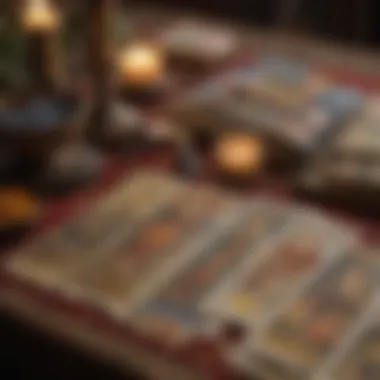
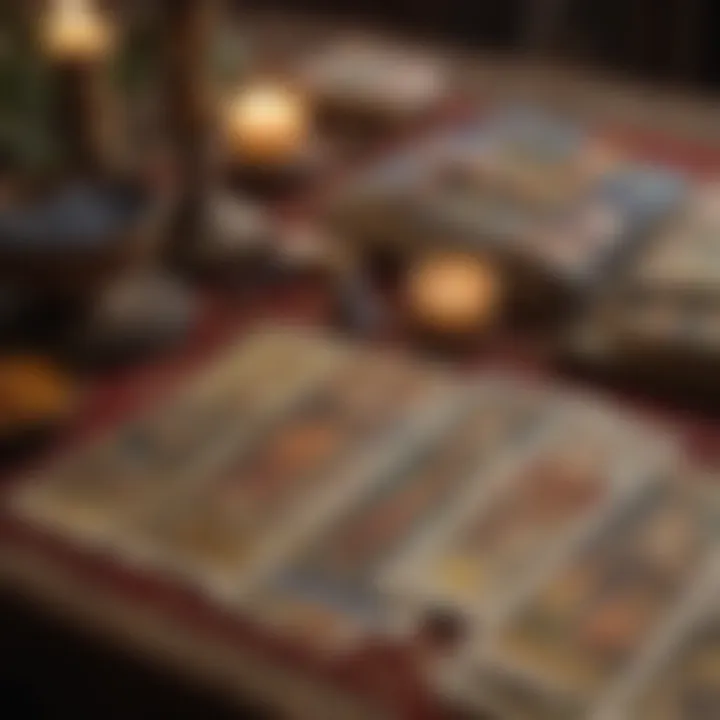
Intro
Reading tarot cards can feel like stepping into a world filled with mystery and self-discovery. For many, the cards serve as a bridge between the conscious and subconscious, providing insights into thoughts, feelings, and potential paths ahead. In a world constantly buzzing with distractions, learning to read your own tarot cards is akin to establishing a personal sanctuary—a space where one can reflect, explore, and grow. This guide aims to equip you with the tools and understanding necessary to embark on this journey.
Whether you’re seeking clarity about a specific situation or a broader understanding of your life’s direction, the practice of tarot can reveal nuances and insights that may remain hidden otherwise. Through a mix of historical context, practical techniques, and personal anecdotes, we’ll dive into the art of tarot reading, ensuring you feel confident as you explore the meanings of each card.
Let's uncover the layers of tarot, beginning with understanding the essential context—the Zodiac. Understanding your astrological influences can deepen your insight into the meanings of the cards and enhance your reading experience.
Prelude to Tarot Reading
Understanding the essence of tarot reading is foundational for anyone embarking on this journey. When you dive into the world of tarot, you're not merely flipping through a deck of cards. You’re engaging with a profound tool that can illuminate the intricacies of your psyche and the circumstances surrounding you. Tarot reading isn’t just a mystical pastime; it serves as a bridge to self-discovery and enlightenment. You learn to decode universal truths and personal narratives, allowing for profound personal insight.
The relevance of grasping the basics of tarot cannot be overstated. Every reader, whether a novice or seasoned practitioner, begins with an informed foundation. This article will take you through the multifaceted nature of tarot. We’ll explore not just what the cards mean, but how they tie into the human experience. By the end, you’ll find that making sense of the cards can lead to long-lasting clarity about yourself and the world around you.
What is Tarot?
At its core, tarot is a compilation of symbolic images and archetypal themes packed into a deck of 78 cards, used for divination, introspection, and guidance. The cards are divided into two main groups: Major Arcana and Minor Arcana. Each card boasts a unique imagery and meaning that reflects different aspects of life, from major life events to day-to-day matters.
Many people think of tarot as just a means of predicting the future, but it’s far more nuanced. It’s a language of intuition and interpretation. When you draw a card, it’s not just about what appears on the surface—it's about the dialogue you engage in with your subconscious, as well as how that relates to your present situation and emotions. Simply put, tarot is a mirror reflecting your inner world.
A Brief History of Tarot Cards
The history of tarot cards stretches back centuries and is steeped in mystery. Though the precise origins are debated, many scholars suggest it began in the 15th century in Northern Italy as a card game known as tarocchi. Initially, these cards were not intended for mystical purposes, but as the centuries went by, they transformed into tools for fortune-telling and spiritual guidance.
The Rider-Waite deck, popularized in the early 20th century, is often credited as one of the first decks to include rich illustrations for every card, linking images to meanings and concepts for enhanced understanding. Other historical decks, like the Marseille and the Visconti, also played significant roles in shaping how tarot is used today.
As tarot mystique waxed, various cultures adopted and adapted these cards, leading to a myriad of interpretations and readings styles. In contemporary times, tarot has become a well-respected practice among a diverse audience, including astrologers, psychics, and those simply seeking a deeper connection with themselves.
"The tarot is a guide to the unconscious: a mirror of your emotions and experiences."
Recognizing the historical context of tarot allows you to appreciate not just the cards themselves, but their enduring resonance as tools of insight and self-exploration. Engaging with this rich mystique helps illuminate why these age-old symbols continue to endure in the modern world.
Understanding the Tarot Deck
Understanding the Tarot deck is essential for anyone looking to tap into the depths of tarot reading. This foundational knowledge lays the groundwork for meaningful interpretations and powerful insights. Essentially, knowing your deck inside and out not only helps you navigate through the various cards, but also establishes a deeper connection between you and the messages they convey. Exploring the structural components as well as the symbolic meanings elevates not just your readings, but your overall comprehension of the tarot as a tool for self-discovery.
Structure of a Tarot Deck
A tarot deck typically consists of 78 cards, divided broadly into two categories: the Major Arcana and the Minor Arcana. Each category has its distinct characteristics that contribute to the nuanced readings one can achieve. Understanding how these structures interweave offers clarity and rich context during a reading.
Major Arcana
The Major Arcana consists of 22 cards, each representing significant life lessons and archetypal themes. Notably, cards like The Fool, The Lovers, and The Tower encapsulate life-changing events and deep psychological shifts. One key characteristic of the Major Arcana is its focus on pivotal moments or soul-searching journeys. Because these cards carry weight, they often resonate with readers in profound ways.
In this article, the Major Arcana is considered a golden ticket for anyone wanting to explore deeper meanings due to its impactful imagery and narratives. The unique feature of the Major Arcana is its capacity to highlight monumental changes or cycles in life, giving readers a clearer picture of their path ahead. However, it could also lead to overwhelm, especially for beginners, as each card invites deep introspection.
Minor Arcana
On the other hand, the Minor Arcana comprises 56 cards and breaks down further into four suits: Cups, Wands, Swords, and Pentacles. These cards reflect the more day-to-day aspects of life—emotions, actions, challenges, and material concerns. The key characteristic of the Minor Arcana lies in its practicality and suitability for detailed readings.
Focusing on the Minor Arcana provides a more immediate lens through which to view situations, making them advantageous for daily draws or more casual inquiries. The unique feature of these cards is their episodic nature, offering insights into particular moments or themes. Yet, their abundance can sometimes dilute the impact, making it harder to grasp the larger narrative at play.
Symbolism in Tarot Cards
Every card in the tarot deck is steeped in symbolism. Understanding these intricate meanings enhances one's ability to interpret readings more accurately. Symbols are not merely decorative; they trigger subconscious responses and resonate with personal experiences.
The imagery in tarot cards often pulls from various cultural heritages, mythology, and spiritual beliefs, making each reading an unfolding tapestry of meaning.
To effectively decode symbolism, one must develop a personal lexicon of meanings while also being open to the evolving interpretations that life presents. Card illustrations can evoke distinct feelings, prompting insights that go beyond the written descriptions in tarot guides.
"The power of tarot is not about fortune-telling; it's a mirror that reflects your inner world."
By familiarizing yourself with the symbols found in both the Major and Minor Arcana, and understanding their context, you lay a solid foundation for future tarot practices. This honed awareness translates into more nuanced and insightful readings, allowing you to connect not just with the cards, but with your own inner wisdom as well.
Preparing for Your Reading
Preparing for a tarot reading goes beyond just shuffling the cards. It lays the groundwork for a meaningful and insightful experience. If you dive into readings without any preparation, you risk missing the deeper messages the cards might hold. Taking the time to logically set the stage can enhance your clarity and perception while interpreting the cards.
Creating a Sacred Space
Establishing a sacred space is like creating your own little sanctuary before diving into the mystical world of tarot. This space doesn’t have to be large or overly ornate, but it should be a place where you feel completely comfortable and undisturbed. Here are some key components to consider:
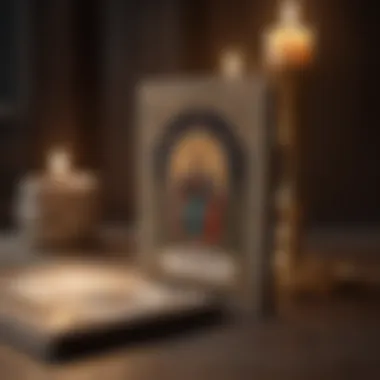
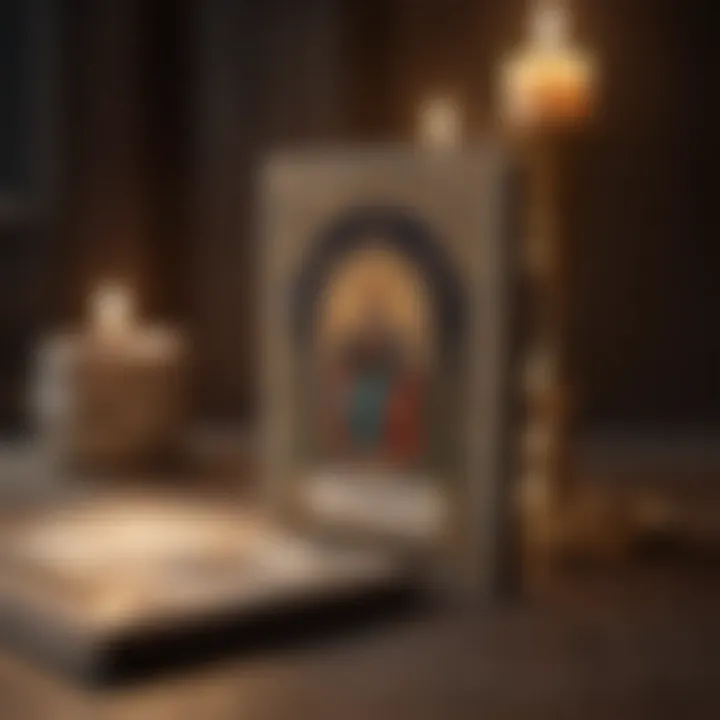
- Choose a Quiet Area: Pick a corner of your home where noise is kept to a bare minimum—somewhere that allows you to zone in on your thoughts and energies.
- Declutter and Cleanse: A tidy space can do wonders for your mental clarity. Clear away any distractions, both physical and emotional. Consider using sage or incense to smudge the area, creating a purified atmosphere.
- Personal Touches: Add elements that inspire you, like crystals, candles, or even images that resonate with your spiritual beliefs. These items can ground you and help channel the energies you wish to connect with.
Balancing light and shadow in the space is also essential, as each element holds its unique significance in the tarot journey. You might make the space dimmer to encourage intuition—or brighter to promote mental clarity. Ultimately, what matters is that you feel right at home.
Setting Your Intention
Setting your intention for the reading can virtually make or break the quality of the insights you’ll receive. Think of it as charting your course before sailing the seas of wisdom. Here are steps to effectively set your intentions:
- Clarity of Purpose: Be specific about what you want to gain from the reading. Are you seeking guidance on a relationship, career choices, or personal growth? Write it down if necessary, as this action can solidify your focus.
- Affirmative Language: Amending your intention to utilize positive language works wonders. Instead of saying, "Will I fail?" you might say, "What opportunities can I embrace for success?" This subtle shift in mindset creates a more inviting energy.
- Visualize Your Outcome: Closing your eyes and picturing the desired outcome can help cement your intentions. Imagine yourself receiving the guidance or resolution that you're seeking.
"Setting a clear intention prepares the mind and heart to receive messages willingly, fostering a deeper connection with your deck."
In essence, both creating a sacred space and setting your intention are integral to tarot reading. They allow you to switch gears from the ordinary hustle of life to the extraordinary insights that only tarot can provide. By approaching your reading with intention and preparation, you are much more likely to uncover the layers of wisdom hidden within the cards.
Choosing the Right Tarot Spread
Selecting the suitable tarot spread is like picking the right tool for a job; it can magnify the insights you receive from your cards. The right spread aligns with your questions and intentions, offering a clearer lens to view your situation. Many individuals stumble in this stage. They either jump into complex spreads or stick to the same old layout that may not serve them anymore. In this section, we'll delve into the nuances of three valuable spreads—each serving a different purpose.
Three-Card Spread
The Three-Card Spread is often a go-to for beginners and seasoned readers alike. This layout is simple yet powerful, providing a concise snapshot of the past, present, and future concerning your query. Here are some points to consider:
- Flexibility: You can use it for various questions, whether exploring your emotions or gauging potential outcomes.
- Simplicity: This spread helps you focus on the essence of your question without overwhelming details.
Here’s how the cards might be interpreted:
- Past: Reflects influences and events that have shaped the current situation.
- Present: Represents the current circumstances and your role in it.
- Future: Provides insight into probable outcomes.
Using this layout can help draw attention to patterns or themes that might be clouding your judgment. If you're unsure, it’s a smart way to start learning about tarot.
Celtic Cross Spread
The Celtic Cross Spread is a time-honored favorite among tarot enthusiasts, admired for its depth and richness. This ten-card spread delves deeply into one's life events and emotional landscapes. Important considerations when using this spread include:
- Comprehensive: It addresses various aspects like external influences, personal beliefs, and underlying issues.
- Detailed insights: Each card holds specific positions, each resonating with a different area of your question, providing a multi-faceted view.
Though a bit more complex, using the Celtic Cross can reveal how past choices affect present circumstances. It’s like opening a book of your life, where every card turns the page to reveal your ongoing story.
Relationship Spread
When looking to understand interpersonal dynamics, the Relationship Spread can offer profound insights. Whether it's a romantic partner, friend, or family member, this layout addresses multiple perspectives, including:
- You: How you perceive the relationship.
- Them: Insights into the other person’s perspective.
- Mutual Experience: What binds the two of you together and where tensions might exist.
This spread can illuminate misunderstandings or unspoken feelings. It often helps clarify how both parties contribute to the relationship's currents. Understanding these influences can suggest paths to improvement or acceptance.
Remember, each spread has its benefits, but the most important part is your intention and connection to your cards. The right choice can make all the difference; trust your intuition.
Interpreting the Cards
Interpreting the cards is a crucial aspect of tarot reading, as it allows readers to unlock the messages and insights hidden within the deck. When done correctly, skilled interpretation can guide personal reflection, spark impactful realizations, and foster a deeper connection to one's intuition. Furthermore, understanding how to read the cards not only enhances your reading experience, but also provides you with a sense of empowerment over your life’s journey.
Reading Individual Cards
Each card in the tarot deck carries its own unique meaning, both in its upright and reversed positions. When reading individual cards, take your time to absorb the imagery, colors, and symbols presented. For instance, the Seven of Cups often represents choices and imagination; however, it can take on different meanings based on context. Consider the emotions you feel as you look at the card. Sometimes, personal intuition will provide a fresh perspective beyond traditional interpretations.
To deepen your understanding, jot down the keywords associated with each card in your journal. This practice fosters an evolving relationship with the deck, as each reading may present new insights. Don't forget that your emotional state at the time of the reading can also influence your interpretation.
Connecting Cards in a Spread
After you've analyzed each card individually, the next step is to weave them together in a narrative, which is akin to piecing a puzzle together. Each card's position in the spread contributes to the overall meaning, connecting the messages and themes in a cohesive manner. For example, if you pull The Fool in the first position of a three-card spread, it may represent a starting point or new adventure, while the neighboring card, say the Three of Pentacles, signals the importance of collaboration and shared goals.
It's also beneficial to look for recurring symbols or themes across the cards. Perhaps you've drawn several cups cards; this signals an emphasis on emotional matters in your life.
Understanding Reversals
Reversals can often be misunderstood, yet they reveal a depth of meaning in tarot reading. A reversed card, for instance, doesn’t simply mean the opposite of its upright counterpart but might indicate internalization or a clue that something needs to be examined closely. The Nine of Swords, when flipped, can indicate anxiety, but maybe it’s more about recognizing the power of fears rather than letting them dictate actions.
When interpreting reversals, ask yourself some key questions. Is there an aspect of this card that feels unexpressed or suppressed? Or is it suggesting that a particular energy is being used in a constructive or destructive way?
"Sometimes what is hidden can illuminate far more than what is shown."
Understanding reversals adds richness to your readings, deepening your insight into the challenges and potentials you're facing.
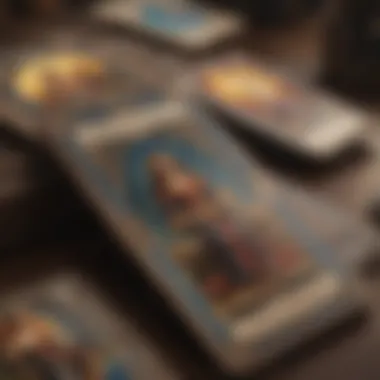
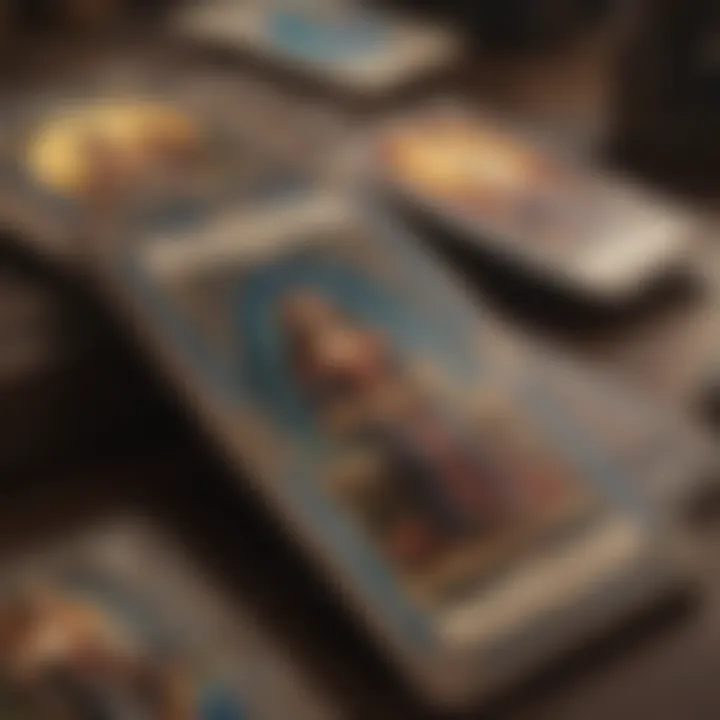
By cultivating a routine where you read, connect, and reflect upon the meanings of the cards, you become attuned to the nuanced whispers of the tarot. Let this process be a rich journey into your own psyche and the world around you, reaffirming the belief that your intuition is a powerful ally in interpreting life’s narrative.
Developing Your Intuition
Gaining a deep understanding of tarot cards is more than just memorizing meanings and spreads; it's about tapping into your intuition. When you develop your intuition, you enhance your ability to interpret the cards in a way that resonates personally with you. The beauty of tarot reading lies in its subjectivity, and intuition is at the core of that experience.
Intuition serves as a bridge between the unconscious and the conscious mind. It allows you to perceive subtle cues from the energy surrounding you, enabling deeper connection with the cards. When you trust your instincts, readings can become more insightful and aligned with your true self. Each card in the tarot deck has layers of meaning, and those meanings can change depending on the context of your question and personal experiences. This is where intuition takes center stage.
The Role of Intuition in Tarot
Intuition isn’t just a handy tool; it’s an integral part of tarot reading. When you shuffle the cards and lay them out, your instinct gives you guidance on how to proceed and interpret. The role of intuition varies from person to person, but certain universal elements can be highlighted:
- Sensitivity to Energy: Just like a sixth sense, intuition makes you attuned to the energy of your surroundings and the emotional state of the moment. Being sensitive to these vibrations often leads to more meaningful insights during a reading.
- Personal Connection: Your unique experiences shape your intuition. As you refine this skill, you start to see how your life's journey links to the cards, resulting in personalized and profound interpretations.
- Decision-Making: Occasionally, the answer to a question you ponder lies not necessarily in the textbook meanings, but rather in the intuitive feelings that arise when you turn over a card. This personal insight can often be more guiding than traditional interpretations.
Exercises to Enhance Intuition
Just like a muscle, intuition can be strengthened with consistent practice. Here are some practical exercises to enhance your intuitive abilities:
- Meditation: Spend a few minutes daily in quiet reflection. Close your eyes, breathe deeply, and think about your tarot practice. Visualize the cards and allow thoughts and insights to flow. This creates a mental atmosphere conducive to intuition.
- Daily Card Pulls: Draw one card each morning. Reflect on its meaning throughout the day and notice how it applies to your experiences. Gradually, you’ll learn to rely on those first intuitive impressions when interpreting its significance.
- Free Writing: Pick a card and write about it for 10 minutes without stopping. This might feel awkward at first, but it allows subconscious thoughts and intuitions to rise to the surface. After reviewing your writing, analyze any insights that may have emerged.
- Engaging with Nature: Spend time outdoors, observing and interacting with your environment. Nature encourages intuitive thinking. Let your mind wander as you enjoy your surroundings, and you may find new insights appear more easily.
It's important to remember that intuition is not about being 'right' or 'wrong.' It's about connection and exploration.
Fostering your intuition will not only help you in tarot readings but will enrich various aspects of your life, allowing you to navigate with confidence and awareness. Keep a curious heart and an open mind, and let your intuition guide you on this journey.
Common Challenges in Tarot Reading
Navigating the world of tarot can be as intricate as decoding a foreign language. The allure of understanding oneself often gets tangled with uncertainties and doubts. In this part of the guide, we're going to delve into some common hurdles that enthusiasts encounter when diving into tarot reading. It’s crucial to recognize these challenges as stepping stones rather than stumbling blocks; they can shape your approach and ultimately enhance the depth of your readings.
Overcoming Self-Doubt
Self-doubt is the shadow lurking behind many tarot enthusiasts. It often whispers insidious thoughts, telling you that you're not good enough, or that your interpretations are wrong. This inner critic can stifle your intuition and lead to a dismissive view of your readings.
To tackle this, it’s vital to understand that tarot is not solely about accurate predictions; it's about personal insights and inner reflection. Here are a few strategies to help dissolve that pesky self-doubt:
- Practice Regularly: Just like any skill, frequent practice builds confidence. Setting a goal to read for yourself daily can make a world of difference.
- Keep a Tarot Journal: Documenting your thoughts and feelings during readings can provide clarity over time. Looking back at previous entries may reveal trends, increasing your self-assurance in your interpretations.
- Embrace Mistakes: Remember, every misread is a learning opportunity. Tarot isn't a science with black-and-white answers; it's an art that requires patience and self-compassion. If you find yourself in doubt, ask: what can I learn from this experience?
"Self-doubt is a thief that robs your ability to shine. It’s always wise to acknowledge its presence but never let it steal your light."
Reading for Yourself vs Others
Reading for oneself brings its own set of challenges distinct from reading others. By the nature of self-exploration, personal readings can often become clouded by our emotions, wishes, and biases. This complexity can make it difficult to maintain objectivity, resulting in interpretive pitfalls.
When considering the differences between reading for oneself and for another, keep these points in mind:
- Emotional Bias: When you read for yourself, emotions can skew your understanding of the cards. A desire for a certain outcome can lead to wishful thinking. It's useful to distance yourself, perhaps by asking a friend to interpret your situation instead.
- Objectivity and Clarity: Reading for others often allows for clearer insights, as you lack personal emotional attachment. This can lead to more profound and objective interpretations.
- Feedback: When reading for someone else, you get immediate feedback, which can help illuminate areas you might not see when focusing inward. Use this opportunity to learn how you might improve when reading for yourself.
- Ask Inspiring Questions: Framing questions differently when reading for yourself can shift your perspective. Instead of asking "What will happen?", consider asking "What do I need to know right now?"
In summary, understanding the nuances of self-doubt and the differentiation between reading for oneself versus others is essential. Embracing these challenges paves the way for profound growth in your tarot journey.
Practicing Tarot Reading
Practicing tarot reading is essential for anyone hoping to hone their skills and deepen their understanding of each card’s significance. Engaging with tarot on a regular basis cultivates not only familiarity with the deck but also enhances intuition and personal insight. Much like any other skill, frequent practice is what transforms the reading from a simple activity into an art form that resonates with the reader’s inner self.
Here are a few key aspects to consider:
- Building Confidence: The more you read, the more confident you become in your interpretations. This confidence is crucial when deciphering meanings that might feel unclear at first glance.
- Personal Growth: Each session can serve as a moment of reflection and self-discovery. As you interpret different spreads, you begin to notice patterns not just in the cards but in your life as well.
- Cultivating Intuition: Regular readings help develop your intuitive abilities. You’ll learn to feel the energies and nuances of each card, going beyond textbook meanings to find your unique interpretations.
In this light, practicing tarot reading should not be seen merely as a task but as a valuable tool for self-exploration and intuition-building.
Daily Card Pulls
Daily card pulls are an excellent way to engage with your tarot deck regularly. By drawing a single card each day, you create a small ritual that can set the tone for your day ahead. This practice offers several benefits:
- Simplicity: Pulling one card is less overwhelming than examining an entire spread, making it approachable for beginners.
- Focus: It encourages you to focus on a particular theme or insight for the day. One card can serve as a guiding thought, helping you navigate daily challenges.
- Reflection: Over time, you can look back on daily pulls to see how the cards' messages manifest in your life, promoting deeper understanding of their meanings.
To get started with daily pulls:
- Set a Time: Choose a consistent time for your daily pull. Many find that mornings work well to set intentions for the day.
- Shuffle Your Deck: As you shuffle, think about what guidance you seek or simply open yourself to receiving general wisdom.
- Draw a Card: Take your time in drawing a card. Trust your instincts.
- Reflect: Spend a few minutes reflecting on the card's meaning and how it applies to your day.
Journaling Your Readings
Keeping a tarot journal is a valuable practice that allows you to track your thoughts and experiences over time. By documenting your readings, you create a personal resource that can aid in your growth and understanding. Here are some important considerations:
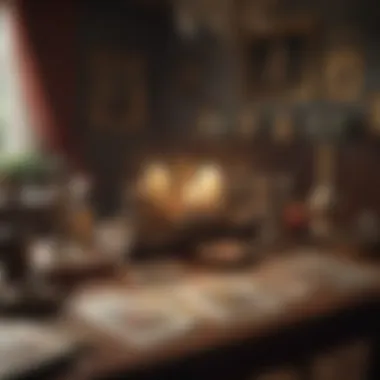
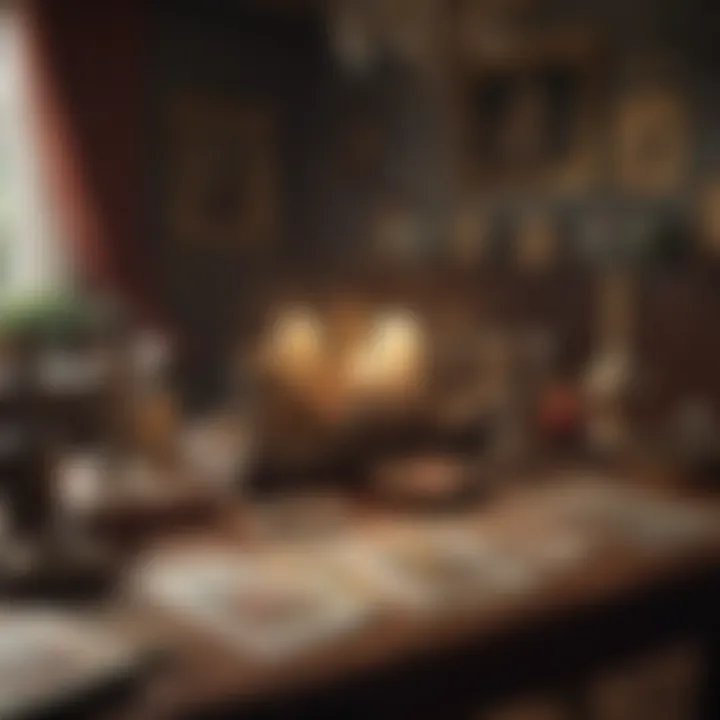
- Record Interpretations: Write down your interpretations of each reading, as well as any feelings or thoughts that come up. This record can help reinforce learning and provide insights when looking back.
- Track Patterns: Regular journaling allows you to identify patterns or recurring messages from your readings. It can reveal how certain cards show up in relation to events in your life, deepening your understanding of their significance.
- Reflect on Growth: Looking back at your early readings will show how far you’ve come in your tarot journey and how your understanding has evolved.
When journaling:
- Include Details: Note the date, the spread, the cards drawn, and your interpretations. Don’t forget to reflect on your emotional response and any significant events during that time.
- Use Different Formats: Doodle, sketch, or use colored pens. Make it an enjoyable and personal space.
- Review Periodically: Set aside time to review older entries. This retrospective practice can yield remarkable insights into your personal development.
In essence, regular practice through daily pulls and insightful journaling can transform your tarot reading experience. They serve as essential tools to deepen your connection with the cards, enrich your intuition, and ultimately guide you on your journey of self-discovery and growth.
"The only way to learn tarot is to practice. Each card becomes clearer and more meaningful with every reading."
By committing to these practices, you’ll find yourself not just reading cards, but also engaging in a dance with your inner self, becoming gently attuned to your thoughts, feelings, and experiences.
Exploring Advanced Techniques
As one continues the journey of tarot reading, it's only natural to wander beyond the basics. Advanced techniques enrich the experience while providing deeper insights into the cards and their meanings. These techniques are especially crucial for those who wish to refine their practice consistently and elevate their intuition to new heights.
When delving into advanced tarot methods, incorporating complementary disciplines such as numerology and astrology can significantly enhance the reading. Each of these avenues provides a different lens through which to interpret the cards, adding layers of meaning that mere card combinations might miss. Moreover, understanding these concepts can bridge the gap between your inner awareness and external influences, enabling a more profound understanding of your life’s journey.
Focus on the specific elements—what numerology and astrology can offer as tools in your readings. Consider how each numeral and astrological sign associates with specific energies and messages, serving to emphasize or clarify the readings. Thus, the benefits of these advanced techniques extend beyond mere insight; they foster a holistic approach to tarot reading.
As you embark on this journey, remember to keep an open mind and stay curious. The exploration of advanced techniques is not only about learning but also about connecting with your intuition on a deeper level. Embrace the complexities, and be prepared for the revelations that await.
Using Numerology
Numerology, the study of the mystical properties of numbers, can greatly enhance your tarot readings. Each tarot card has a numerical value, and these numbers resonate with specific vibrations. By understanding these associations, you can layer additional meaning onto your readings.
For instance, consider the way the number 1 represents new beginnings, encapsulated in the Fool card. Conversely, the number 10, representing completion or transition, is reflected in the Wheel of Fortune. The relationships between numbers and cards can illuminate patterns in your life, guiding you toward clarity.
Some practical ways to incorporate numerology include:
- Identifying card numbers: Check the numbers in your tarot draw. Each number can trigger insights related to events, emotions, and decisions.
- Calculating personal numbers: Combine the numbers from your birth date or other significant dates to find your personal numerological influences, then apply these to your tarot readings.
- Exploring recurring themes: Pay attention when certain numbers seem to appear frequently in your readings. This could indicate a strong message from your subconscious.
By engaging with numerology, you deepen your connection to the tarot, uncovering wealth of themes that might otherwise go unnoticed.
Incorporating Astrology
Astrology and tarot have a harmonious relationship, with many tarot cards corresponding to astrological signs and planetary influences. Integrating astrology can help you contextualize your tarot readings within a larger cosmic framework, providing enriching insights.
Each suit in the tarot deck can be associated with a particular element, which in turn corresponds with specific astrological signs:
- Cups and water: Relating to emotions, intuition, and relationships, represented by Cancer, Scorpio, and Pisces.
- Wands and fire: Symbolizing passion and action, linked with Aries, Leo, and Sagittarius.
- Swords and air: Engaging with intellect and thoughts, represented by Gemini, Libra, and Aquarius.
- Pentacles and earth: Focused on material aspects, associated with Taurus, Virgo, and Capricorn.
You can incorporate astrology into your readings by:
- Reading tarot during astrological events: Use specific astrological events, like the new moons or eclipses, to perform readings that resonate with broader universal themes.
- Linking card meanings to astrological traits: Recognize how the traits of zodiac signs impact the interpretation of connected tarot cards. For example, the Empress card may have heightened significance when reading it under the influence of Venus.
- Creating astrology-focused spreads: Design spreads that specifically address astrological influences, such as transits or synastry in relationships.
By weaving astrology into your practice, you not only gain new dimensions in your readings but also amplify the connections between your inner and outer world, enriching the experience significantly.
"The stars have aligned, inviting you to explore the interconnectedness of your inner self and the universe through Tarot."
Finale
Understanding how to read your own tarot cards goes beyond mere divination; it’s a profound journey into one's psyche. This article offers significant insights into aspects that can enhance your tarot practice, from the foundational knowledge of tarot history to advanced techniques like incorporating astrology. By recognizing the meanings of individual cards and how they interact in various spreads, you cultivate a deeper connection to your intuition and personal growth.
The benefits of mastering tarot reading are plentiful. First, it empowers you to seek clarity in life choices and challenges. In the midst of confusion, a simple card pull can offer direction and illuminate hidden opportunities. Moreover, the practice reinforces self-reflection, giving you a clearer view of your desires, fears, and motivations.
However, one must approach tarot with the right mindset. It’s important to recognize that cards do not dictate fate; rather, they present options and suggest paths. Ultimately, tarot reading is about personal agency and the free will to shape your future. Considerations surrounding self-learning in tarot can be daunting, but with persistence and an open mind, mastery is attainable.
Embracing the Journey of Tarot Reading
The journey of learning to read your own tarot cards is as enriching as it is revealing. At its core, tarot is about exploration—of self, surroundings, and the nuances of life. Each reading you conduct not only presents a mapped-out response but invites you to engage with your inner thoughts, fostering a dialogue between mind and spirit.
When you embrace this journey, you learn to approach life's complexities with an open heart and a curious mind. Reading tarot cards can feel like walking a tightrope between intuition and intentionality, requiring practice and patience. As you navigate through different spreads and interpretations, expect moments where meanings clash or clarify unexpectedly.
Remember, every tarot deck is a reflection of you. It resonates with your energy and perspective. As such, the cards will often convey messages that confirm your intuition or challenge preconceived notions. Each experience forms a layer of understanding, cultivating wisdom through both the good and bad readings.
Resources for Continuing Learning
Venturing into the world of tarot doesn't have to be a solo uphill trek. Here are some valuable resources that can bolster your journey and expand your knowledge:
- Books:
- Online Forums:
- Websites:
- The Ultimate Guide to Tarot by Liz Dean—offers contemporary and practical advice.
- Tarot for Your Self by Mary K. Greer—great for personal exploration and intuition.
- Reddit Tarot Community—an engaging forum for discussions, shared readings, and advice.
- Facebook Groups—join groups dedicated to tarot enthusiasts sharing experiences and insights.
- Wikipedia—provides an extensive overview of tarot history.
- Britannica—offers scholarly articles on tarot and its cultural implications.
By actively seeking to learn and engage with these resources, you will foster a more nuanced understanding of tarot, ultimately developing a practice that is reflective of your unique journey.







